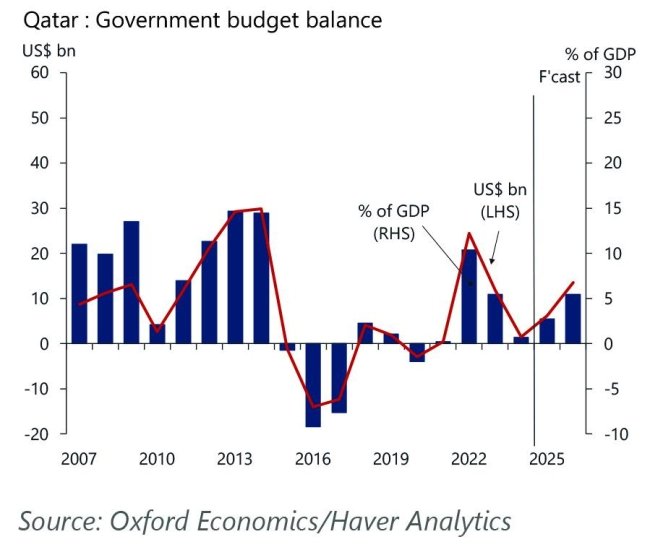
Qatar’s public spending will rise this year despite hydrocarbon revenue headwinds, Oxford Economics has said in its latest country outlook. The 2025 budget targets a deficit of QR13.2bn (1.6% of projected GDP). The authorities plan to raise spending by 4.6% relative to last year’s budget and 1.2% relative to realised expenditure, with a strong focus on development in education and healthcare.
The 2025 budget targets a deficit of QR13.2bn (1.6% of projected GDP). The authorities plan to raise spending by 4.6% relative to last year’s budget and 1.2% relative to realised expenditure, with a strong focus on development in education and healthcare, according to the report.
The budget assumes an average oil price of $60 per barrel.
Oxford Economics said its 2025 Brent oil price forecast remains at $68.10/b. This is higher than what is assumed in the Qatar budget, underpinning its view of another budget surplus this year.
“We project a surplus of QR23bn (2.8% of GDP), larger than the surplus of QR5.6bn (0.7% of GDP) realised in 2024. We see the balance improving to 5.7% of GDP next year amid the LNG production boost,” Oxford Economics noted.
According to the researcher, Qatar’s April PMI signalled softer activity momentum at the start of the second quarter (Q2), driven by a reduction in new business, likely linked to US tariff announcements.
Heightened external uncertainty also weighed on sentiment, pushing the rate of hiring to the lowest since August, even as it stayed elevated.
Oxford Economics’ 2025 average inflation estimate (for Qatar) remains at 1%, the lowest in the GCC region.
“We think any upward pressure on imported inflation from recent US dollar weakness (via the currency peg) will likely be offset by the dampening effect of tariffs on global demand.
Qatar’s annual inflation rate was negative in Q1 for the first time since early 2021. Prices fell by 0.8% quarter-n-quarter (q-o-q) in seasonally adjusted terms, led by declines in food prices and the cost of recreation and culture.
The 3.2% y-o-y fall in food prices in Q1 was among the largest in the current series. The drag from the housing and utilities category on annual inflation deepened, with prices falling by 4.5% y-o-y, the most since Q3, 2021.
“We still expect inflation to settle at around 2% in the medium term,” Oxford Economics noted.
The Qatar Central Bank (QCB) followed the US Federal Reserve in holding interest rates steady in May, continuing the pause from January.
In 2024, the US Fed delivered a cumulative 100bps of cuts.
Meanwhile, the QCB cut rates by a total of 115bps, with the lending rate at 5.1%.
“In the coming months, we think the QCB’s rate moves will echo those in the US, as we continue to expect the Fed to stay on pause until December. Our baseline anticipates a further 100bps of cuts next year,” Oxford Economics said.





